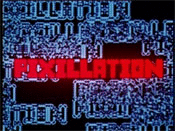This weekend the Tate Modern celebrates the UK's Spring bank holiday with three days of playful events, from May 24-26. These include a Graffiti Research Lab workshop, what is sure to be an epic performance by Patrick Wolf and John Kelly in accompaniment to two of Nan Goldin's slide lectures, and a Flux-Olympiad--artist Larry Miller's realization of Fluxus artist George Maciunas's fantasy of a suite of oddball sporting events questioning the relationship between art and talent. These and other heavily Fluxus-inspired programs are geared around the museum's "States of Flux" exhibition, which looks at art addressing change, progress, and movement. This is a very interesting context in which to present one of The Long Weekend's most exciting events: large-scale architectural projections assembled under the rubric of "Past-Potential-Futures: Early Experiments in Computer Animation." Seminal pieces by artist/programmers Charles Csuri, Ed Emshwiller, Pierre Hébert, Denys Irving, Kenneth Knowlton, Malcolm Le Grice, Lillian Schwartz, John Stehura, Stan VanDerBeek, and others will be presented in this screening, whose program notes warn of the event's unsuitability "for those susceptible to photo-sensitive epilepsy." Though very few of these artists aligned themselves explicitly with Fluxus, their works similarly shook things up in the '60s and '70s as beacons for experimentation, pushing notions of the artist's identity and tools while evoking an important relationship between instruction (code) and the formal objects of their creation, anticipating the "new media" in many ways, while also harkening to the history of proto-cinematic animation with shadows, paper, and celluloid that had altogether escaped the aperture of any cameras. The event's title couldn't be more perfect, as these pulsating, kinetic films will hit viewers' eyes like luminous time capsules of a future yet to be realized. - Marisa Olson
Image Credit: Lillian Schwartz, Pixillation, 1970